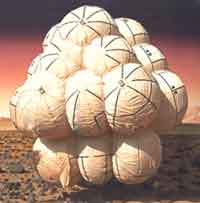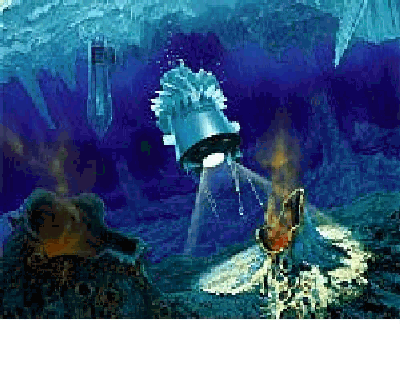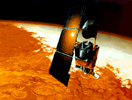The Unofficial Space Exploration Page for Life on Mars & Jupiter's Europa
The Search for Life in our Solar System on Mars and Jupiter's Moons
Tired of annoying pop-up ads? Download PopupDummy!

We are once again on Mars (01/10/04)


NASA has successfully landed a rover on the surface of Mars. The lander came down packaged in a bunch of airbags, bounced many times, and finally came to rest unharmed. Here is the first-ever, full color picture of the surface of Mars. It is quite an improvement in quality compared to the previous surface picture taken by the original rover in 1997.

Take a close look at this surface picture below taken by the rover Spirit. The strange muddy marks you see were created by the airbags of the rover as it bounced and dragged on the ground before coming to a stop. Apparently, something in the martian soil allows what appears to be a muddy track. Notice how the mud material seems to curl upwards, almost like melted plastic. This appears to be a material we have not yet seen on Earth. Could it signify water?

Where does NASA believe Life is likely to exist?
The search for life could ultimatly lead to findings anywhere. However, NASA believes the most likely places
within our own solar system to harbor life may have been Mars, some time ago. There may also exist underground
tunnels of water and lakes which currently harbor life forms such as bacteria. Another place scientists are
very interested in as a source of life, is one of Jupiter's moons, Europa.
Whats so special about Europa? What is it anyway?

Europa is one of Jupiter's moons as seen in the list of moons here. Europa's ice surface makes it one of the brightest, and smoothest, objects in our solar system. Its surface is -260° F, which could freeze an ocean over several million years. But scientists think that the warming caused by a tidal tug of war with Jupiter and neighboring moons could be keeping large parts of the ocean liquid. Many of Jupiter's moons are
quite facinating to scientists, simply because of their many unique characteristics not found anywhere else
in the solar system. Just take a look at the images depicted of them. However, it is Europa that has scientists
interested the most. Recent fly-bys from the Galileo spacecraft (1998-2000) have shown Europa to contain a slushy,
ice / water surface. It is estimated to have more liquid water than contained on Earth in total. The other
aspect towards life on Europa is that the moon contains very active tectonics. Tectonics is the system that drives
the movement of a planets crusts - such as volcanos, earth quakes, magma. Tectonics are important because they
drive a planet to release certain gases and shapes, which can be fundamental to the existence of life.
 The Galileo spacecraft passing by Jupiter.
The Galileo spacecraft passing by Jupiter. 
 As seen in this picture to the right, the redish streaks are volcanic activity over the watery/icy surface. Scientists
speculate life forms may exist under the crust of ice, living in the salty oceans below. Since Europa has
volcanic activity (much like Earth does), it may also contain Hydrothermal Vents on its ocean floor. On Earth,
these vents have been found to harbor sea life in the most devastating conditions - so why not on Europa as well?
As seen in this picture to the right, the redish streaks are volcanic activity over the watery/icy surface. Scientists
speculate life forms may exist under the crust of ice, living in the salty oceans below. Since Europa has
volcanic activity (much like Earth does), it may also contain Hydrothermal Vents on its ocean floor. On Earth,
these vents have been found to harbor sea life in the most devastating conditions - so why not on Europa as well?
It sounds awsome! Are we planning to get to Europa soon to explore it?
 The thing different about exploring Europa than Mars, is that this Jupiter moon lies in the outer solar system.
Mars is much closer, and so getting a probe to Europa would be much more challenging - yet having it land and still
be able to communicate with it to instruct it to do things when it is so far away. There was already a delay of a few
minutes when talking to the probes on Mars. So talking to one on Eurpoa with our present technology would take even
longer. Possible a pre-programmed robot could do the job - plunging to Europa's surface and drilling into its ice
crust to peek into the oceans below.
The thing different about exploring Europa than Mars, is that this Jupiter moon lies in the outer solar system.
Mars is much closer, and so getting a probe to Europa would be much more challenging - yet having it land and still
be able to communicate with it to instruct it to do things when it is so far away. There was already a delay of a few
minutes when talking to the probes on Mars. So talking to one on Eurpoa with our present technology would take even
longer. Possible a pre-programmed robot could do the job - plunging to Europa's surface and drilling into its ice
crust to peek into the oceans below.
How about a flyby mission like we did with Mars? Or an orbiter?
 The most current mission planned by NASA within the next 3 years is an orbiter mission around Europa. It will
orbit the moon and scan the surface with radar to determine the thickness of the icy crust, and possibly the
depth of the oceans underneath. It will also try to detect if the ocean is indeed a salty one.
The most current mission planned by NASA within the next 3 years is an orbiter mission around Europa. It will
orbit the moon and scan the surface with radar to determine the thickness of the icy crust, and possibly the
depth of the oceans underneath. It will also try to detect if the ocean is indeed a salty one.
NASA is also preparing plans for a possible mission to Europa that would put a lander on the surface. It has even been suggested that a mission could be devised that would drill through the ice layer and release a probe into the liquid underment. This is the hydrobot concept, illustrated below.

Life on Mars, aliens or us?
What was the status of the Mars Polar Lander on Sunday, December 5th 1999 12:50PM?
This was the last Polar Lander entry on this web site when the lander was to touch down on Mars:
The next communication opening for the Lander to talk to Earth will be at 2pm EST today (Sunday Dec 5th). At that time the lander will be searching with its medium-gain antenna for Earth to talk to us. Its antenna must be within 15 degrees of our planet in order for us to read its signal, this is why searching for Earth can take so long. If the lander is still not
heard from at 2pm EST, there will be another opening Sunday night (2am EST) at which point the lander will attempt to
bounce a signal off the Mars Global Surveyor to relay back to Earth. Let's keep our fingers crossed for the Lander
to talk to us. However by then, the possibility of an error becomes more real. If no communications can be received from the lander by Thursday, it has a built-in timer to begin making repairs to its own hardware as a final fall-back plan and attempt to establish communications after.
The Polar Lander - Failure, What About It?
The Polar Lander has failed, likely crashed into a canyon wall or large rock and critically damaged. It is also possible
the Lander touched down in a fatal position such as on its side, and could not operate. This is a tragic set-back
in the exploration of our solar system, and may result in cutting funding from NASA.
What about the manned mission to Mars in 2015?
The US may be cutting funding to NASA to explore Mars, but you CAN still make a difference! Sign the ThinkMars petition and join hundreds of thousands of others from around
the world in bringing voice to our governments to have a manned mission to Mars in the year 2015!
 If 1 million names are entered by Novemeber, 2000, the petition will be brought to the USA congress and to the president at that time
to be considered to push for a true manned mission to Mars! Click the Humans To Mars picture below to sign the petition or just
click here.
If 1 million names are entered by Novemeber, 2000, the petition will be brought to the USA congress and to the president at that time
to be considered to push for a true manned mission to Mars! Click the Humans To Mars picture below to sign the petition or just
click here.
 Download the image on the right as desktop wallpaper! click here
Download the image on the right as desktop wallpaper! click here
What was the Mars Polar Lander?

The Mars Polar Lander was the second landing operation on Mars to happen in the end of 1999. There is an image of it at the top of this page, (which, by the way, makes an excellent Window Desktop picture). If you remember, the first Lander was launched around 1997 and analyzed the soil and weather on Mars. This lander's main mission was be to search for signs of water and life. It was to land on one of the poles of Mars - an area more probable to contain frozen water and a better history of ancient changes such as fossiles, weather, seismic activity. This lander was much more advanced than the previous rover. It was planned to communicate more effectively with Earth by taking advantage of the Climate Orbiter that would be in orbit around Mars, but since the Orbiter was lost, it would have had to use its own communications as a back-up plan. The lander's mothership, before launching the lander down to the planet's surface, would first fire off 2 missle-type objects called the Deep Space 2 probes. These probes would impact into the martian surface about 5 kilometers and begin drilling in. They would have then began relaying information back to Earth on the temperature, water content, and other details on the martian soil at deeper depths than the rovers can access.

A Martian sunset taken by the first rover lander 2 years
ago.
A strip of gentle, rolling plains near the Martian south pole was to serve as a welcome mat when NASA's Mars Polar Lander touches down on the red planet on December 3, 1999." - NASA
The landing site for this rover is much more interesting than the previous landing site. The previous site was likely a martian desert. This site is one of the poles of Mars, and may contain some gentle mountains as well as icy patches.

The Mars Climate Orbiter has been destroyed 9/23/1999 at
around 2:15am (scroll down)
What is it? And What Happened?

 On the left is an image taken by the Mars Climate Orbiter from about 2.5 million miles away from Mars, on its way there. On the right is an image of the Orbiter at work.
On the left is an image taken by the Mars Climate Orbiter from about 2.5 million miles away from Mars, on its way there. On the right is an image of the Orbiter at work.
The Mars Climate Orbiter was to be the first weather sattelite to ever orbit another planet. It would track the weather patterns and contents of the martian atmosphere. More importantly, it was to be used as the primary relay station for the next two lander missions to come. However, as it approached the Mars orbit, a software error caused the Orbiter to enter much too low into the Martian atmosphere - within 36 miles of the ground, thus causing it to break apart and burn up. With its mission to find water on Mars, this is truly a great lost to mankind and science. However, there is still hope on the recovery of the science.
On December 3, 1999, the Martian Polar Lander, which can be seen at the top of this page, was to land on the martian surface to search for signs of water and life. It was to use the Climate Orbiter as a communications "mirror" to bounce signals off and relay them back to Earth, but will instead, now use its own internal communications to talk back to Earth. Visit the NASA homepage for the Climate Orbiter to learn more and the mission failure and to check out the current weather on Mars today! Read below for details on the Polar Lander misssion. Just Click Here.
Quite possibly, all these 'attacks' on Mars are a precursor to our manned mission to Mars, due to take place around 2015. The first humans will walk on Mars, to begin a human settlement there. It is likely these first humans on Mars will be leaving Earth with the
very real possibility of never returning home again. Mars will become their new home, as they will be forging the new path of colonies for us back on Earth just as the pilgrims did when they landed on the New World here in America.

What do you think about Life on other planets or moons in our solar system? How about in the universe? Do you think any could be intelligent or just animals?
Post your view in the Life on Mars Forum by clicking below and let the world know.
Visit Life On Mars Forum
Possible future pioneers on mars

 Sponsered by k.soft - Tired of popups on the web?
Please support us, click here.
Sponsered by k.soft - Tired of popups on the web?
Please support us, click here.








 The Galileo spacecraft passing by Jupiter.
The Galileo spacecraft passing by Jupiter. 
 As seen in this picture to the right, the redish streaks are volcanic activity over the watery/icy surface. Scientists
speculate life forms may exist under the crust of ice, living in the salty oceans below. Since Europa has
volcanic activity (much like Earth does), it may also contain Hydrothermal Vents on its ocean floor. On Earth,
these vents have been found to harbor sea life in the most devastating conditions - so why not on Europa as well?
As seen in this picture to the right, the redish streaks are volcanic activity over the watery/icy surface. Scientists
speculate life forms may exist under the crust of ice, living in the salty oceans below. Since Europa has
volcanic activity (much like Earth does), it may also contain Hydrothermal Vents on its ocean floor. On Earth,
these vents have been found to harbor sea life in the most devastating conditions - so why not on Europa as well? The thing different about exploring Europa than Mars, is that this Jupiter moon lies in the outer solar system.
Mars is much closer, and so getting a probe to Europa would be much more challenging - yet having it land and still
be able to communicate with it to instruct it to do things when it is so far away. There was already a delay of a few
minutes when talking to the probes on Mars. So talking to one on Eurpoa with our present technology would take even
longer. Possible a pre-programmed robot could do the job - plunging to Europa's surface and drilling into its ice
crust to peek into the oceans below.
The thing different about exploring Europa than Mars, is that this Jupiter moon lies in the outer solar system.
Mars is much closer, and so getting a probe to Europa would be much more challenging - yet having it land and still
be able to communicate with it to instruct it to do things when it is so far away. There was already a delay of a few
minutes when talking to the probes on Mars. So talking to one on Eurpoa with our present technology would take even
longer. Possible a pre-programmed robot could do the job - plunging to Europa's surface and drilling into its ice
crust to peek into the oceans below. The most current mission planned by NASA within the next 3 years is an orbiter mission around Europa. It will
orbit the moon and scan the surface with radar to determine the thickness of the icy crust, and possibly the
depth of the oceans underneath. It will also try to detect if the ocean is indeed a salty one.
The most current mission planned by NASA within the next 3 years is an orbiter mission around Europa. It will
orbit the moon and scan the surface with radar to determine the thickness of the icy crust, and possibly the
depth of the oceans underneath. It will also try to detect if the ocean is indeed a salty one.
 If 1 million names are entered by Novemeber, 2000, the petition will be brought to the USA congress and to the president at that time
to be considered to push for a true manned mission to Mars! Click the Humans To Mars picture below to sign the petition or just
click here.
If 1 million names are entered by Novemeber, 2000, the petition will be brought to the USA congress and to the president at that time
to be considered to push for a true manned mission to Mars! Click the Humans To Mars picture below to sign the petition or just
click here. Download the image on the right as desktop wallpaper! click here
Download the image on the right as desktop wallpaper! click here



 On the left is an image taken by the Mars Climate Orbiter from about 2.5 million miles away from Mars, on its way there. On the right is an image of the Orbiter at work.
On the left is an image taken by the Mars Climate Orbiter from about 2.5 million miles away from Mars, on its way there. On the right is an image of the Orbiter at work.
 Sponsered by k.soft - Tired of popups on the web?
Please support us, click here.
Sponsered by k.soft - Tired of popups on the web?
Please support us, click here.